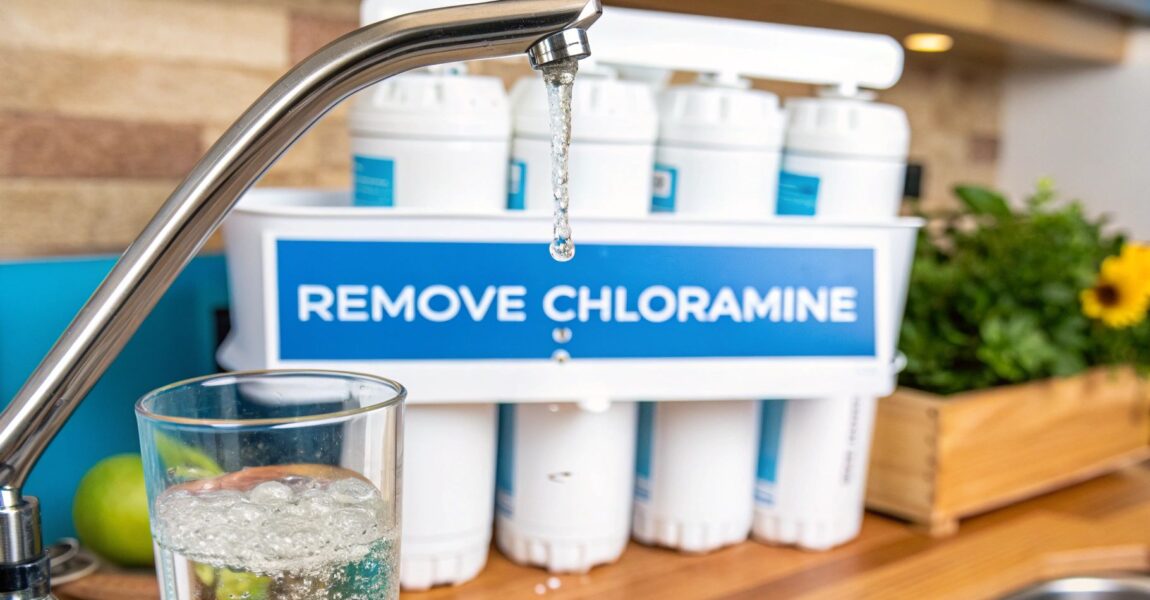
If you’ve ever poured a glass of water and thought, "Hmm, smells like a swimming pool," you might be quick to blame chlorine. But these days, the culprit is more likely chlorine's tougher, more persistent cousin: chloramine. It's a blend of chlorine and ammonia, and it’s the new go-to disinfectant for many water treatment plants to keep our supply safe all the way to your home.
What Is Chloramine and Why Is It in Your Water?
So, why did your local utility make the switch to this super-disinfectant? It all comes down to staying power.
Built to Last in the Pipes
Standard chlorine is a fantastic germ-killer, but it has the stamina of a sprinter. It fizzles out pretty quickly. By the time water travels through miles and miles of pipes to reach your house, that chlorine protection can wear off, giving nasty microorganisms a chance to throw a party before they get to your faucet.
Chloramine, on the other hand, is a marathon runner. It's designed for the long haul and doesn't fade away easily, providing what's known as a "disinfectant residual." This ensures your water stays protected right up until the moment you turn on the tap. That stability is the number one reason so many cities have made the switch.
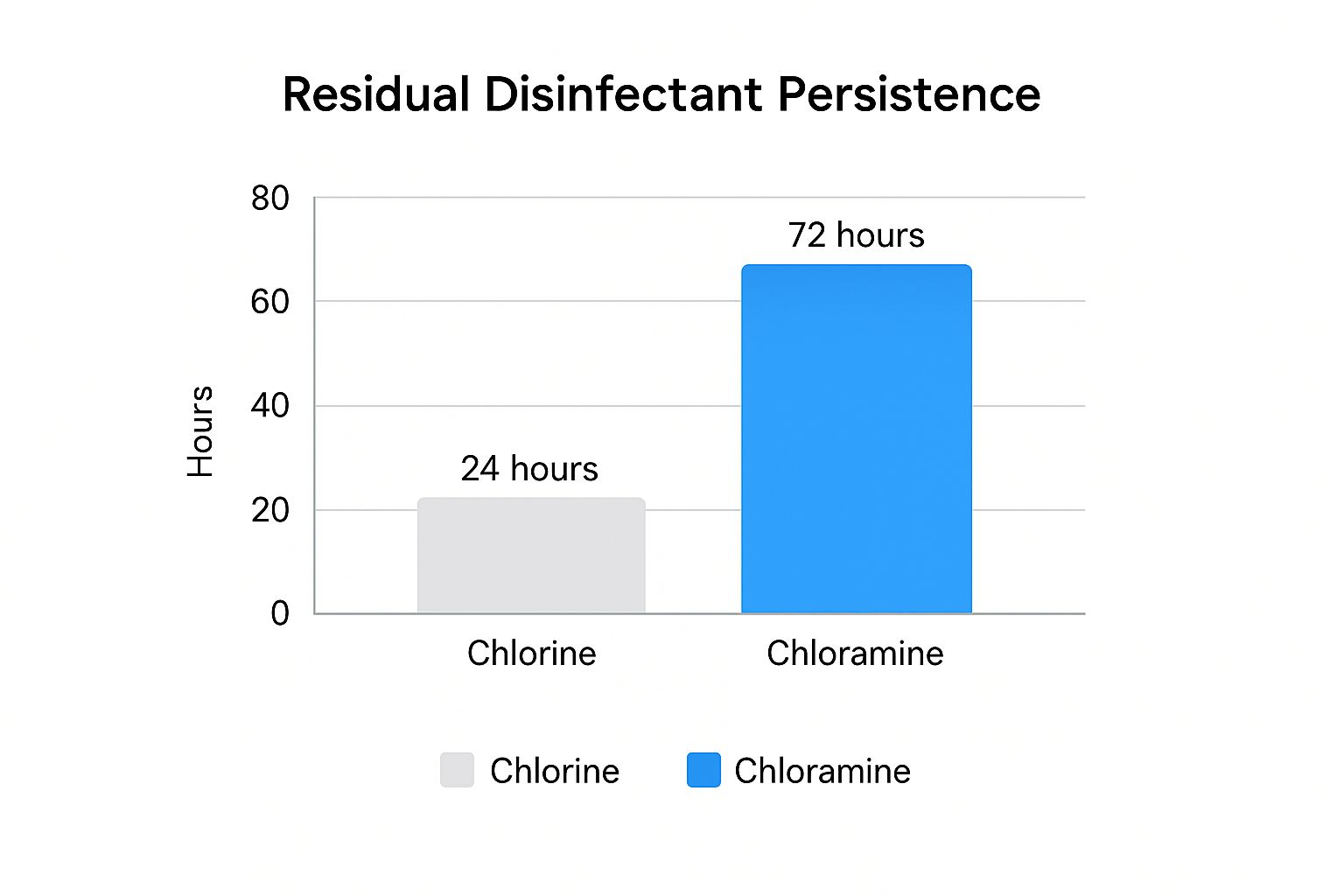
As you can see, chloramine's persistence is a huge plus for water utilities, lasting three times longer than free chlorine.
This isn't a brand-new idea. While chlorine has been used in water since around 1908, chloramine started popping up in the 1930s. The real push came more recently as regulations tightened to reduce harmful disinfection byproducts. In fact, between 2007 and 2010 alone, chloramine use jumped by about 37% in the U.S. as utilities sought safer alternatives. You can dig deeper into the history of water disinfection on NCBI.
So Why Would You Want to Remove It?
While chloramine is a public health hero for your city, its stubborn nature can cause some real headaches inside your home. Once you get the downsides, you can decide if a home water filtration system is the right move for you.
Here are the most common reasons people want it gone:
- Bad Taste and Smell: That chemical funk can ruin a perfectly good cup of coffee or a pot of pasta. Many people just find the flavor and odor of chloraminated water flat-out unpleasant.
- Dry Skin and Hair: Ever step out of the shower feeling like your skin is tight and your hair is brittle? Chloramine is notorious for stripping away natural oils, leading to dryness and irritation.
- Trouble for Hobbies: This is a big one for enthusiasts. Chloramine is toxic to fish and can kill them, making it a nightmare for aquarium owners. It can also throw a wrench in the works for homebrewers by messing with delicate yeasts.
Knowing why chloramine is used and why you might want it out of your life is key. The goal isn't just to remove a chemical; it's to get your water back to a state that's pure, pleasant, and perfect for everything you do at home.
The Best Way to Filter Out Chloramine
If you’re on a mission to kick chloramine out of your water, you've probably heard about "carbon" filters. But here's a crucial secret most people don't know: not all carbon is created equal. The chemical bond in chloramine is notoriously tough—way more stubborn than plain chlorine—and your average carbon filter just can't crack it.
This is where a special kind of filter media enters the scene: catalytic carbon. Think of it as activated carbon's smarter, more powerful older sibling. While standard activated carbon just passively traps contaminants, catalytic carbon is engineered to actively break apart the chloramine molecule.
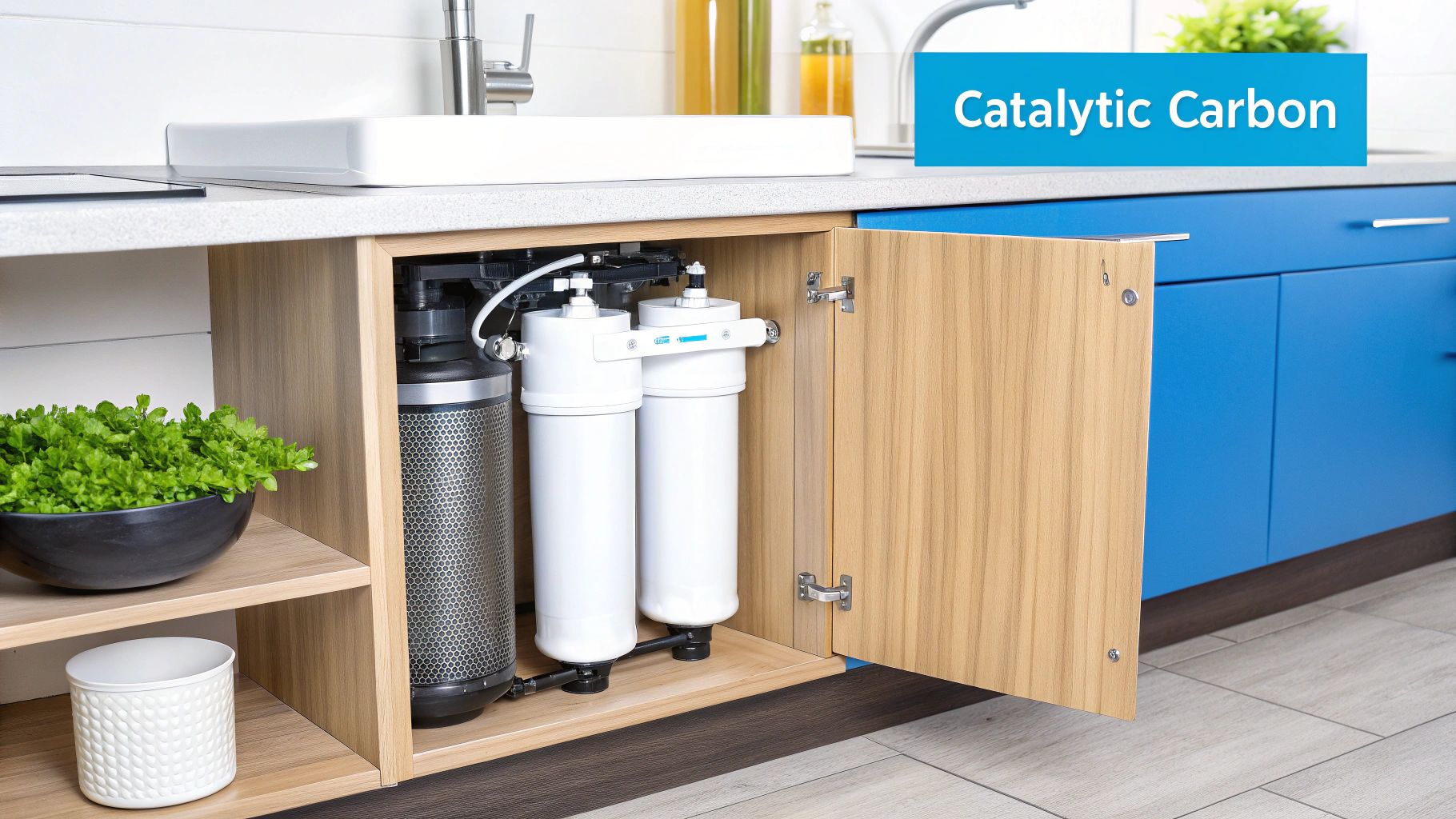
It works by triggering a chemical reaction that splits the bond between chlorine and ammonia. This catalytic action is the secret sauce, neutralizing the chloramine and leaving you with water that tastes, smells, and feels noticeably better. It's the gold standard for a reason.
Why Standard Carbon Fails and Catalytic Carbon Wins
Let me put it this way. Trying to remove chloramine with a standard activated carbon filter is like trying to open a high-security lock with a regular house key. You might jiggle it around and get lucky once in a blue moon, but it’s simply not the right tool for the job.
Catalytic carbon, on the other hand, is the master key cut specifically for that lock. It slides in, turns, and gets the job done instantly. It's built to promote the exact chemical reaction needed to dismantle chloramine, making it wildly more efficient and perfect for a home water filtration system.
This isn't just theory—it's a critical solution for the 20% of Americans whose water is treated with chloramine. With the right setup, catalytic carbon can slash chloramine levels by over 90%, all without tanking your water pressure. You can dive deeper into the official chloramine treatment guidelines on WQA.org.
The bottom line is this: you need a filter that does more than just trap stuff. For chloramine, you need a filter that actively dismantles it. That's what catalytic carbon does.
To help you see the difference, here’s a quick comparison of the most common filter options.
Comparing Chloramine Filtration Media
| Filtration Media | Effectiveness on Chloramine | Best For | Relative Cost |
|---|---|---|---|
| Catalytic Carbon | Excellent (90%+ reduction) | Whole-house (POE) or dedicated drinking (POU) systems specifically targeting chloramine. | $$$ |
| Standard Activated Carbon | Poor (Minimal reduction) | Chlorine removal, taste, and odor improvement. Not recommended for chloramine. | $ |
| Coconut Shell Carbon | Fair to Good (Moderate reduction) | Point-of-use filters where space is limited; better than standard carbon but not as effective as catalytic. | $$ |
As you can see, if chloramine is your main enemy, catalytic carbon is the undisputed champion, even with the higher initial investment.
Two Paths to Clean Water: At the Tap or for the Whole House
Once you know catalytic carbon is the secret weapon, your next big decision is where to put it. This really comes down to two main strategies, each with its own pros and cons.
- Point-of-Use (POU) Systems: These are smaller filters that treat water at a single fixture, like your kitchen sink or showerhead.
- Point-of-Entry (POE) Systems: Often called whole-house systems, these are beefy units installed where your main water line enters the house, treating every single drop you use.
Let's break down what this looks like in the real world.
The Targeted Approach: Point-of-Use (POU) Filters
A POU system is a fantastic choice if your main concern is the water you drink and cook with. Think of an under-sink filter dedicated to your kitchen faucet. It's out of sight, relatively easy to install, and concentrates its filtering power right where it matters most for consumption.
Pros of POU Systems:
- Budget-Friendly: The upfront cost is much lower than a whole-house setup.
- Easy to Install: Many models are designed for a straightforward DIY installation.
- Focused Power: You get incredibly pure water for drinking without paying to treat the water flushing your toilet.
Cons of POU Systems:
- Single-Location Treatment: Your shower, washing machine, and bathroom sinks still get untreated water.
- Slower Flow: Can sometimes reduce the flow rate at the faucet it's connected to.
- More Frequent Changes: The smaller cartridges need to be replaced more often than a large POE tank.
If you're renting, living in an apartment, or just want to drastically improve the taste of your drinking water, a POU filter is often the most practical and effective solution.
The All-in-One Solution: Point-of-Entry (POE) Systems
Now, for the total home upgrade, there’s the point-of-entry, or whole-house, system. This is the go-to for anyone who wants to get chloramine out of every tap, shower, and appliance. By installing it at the main water line, you're essentially creating a protective shield for your entire home.
For instance, if you or your family members have sensitive skin, you know how drying shower water can be. A whole-house system removes that chloramine, which can make a huge difference in skin irritation and brittle hair. It also protects your expensive appliances—like the dishwasher and water heater—from the long-term corrosive damage chloramine can cause.
Pros of POE Systems:
- Complete Home Coverage: Clean, filtered water from every single faucet.
- Healthier Showers: Helps reduce skin dryness and hair damage by removing irritants.
- Protects Your Home: Extends the life of your plumbing and water-using appliances.
- Low Maintenance: The massive filter media tanks can last for years before needing replacement.
Cons of POE Systems:
- Bigger Investment: The initial cost for the system and installation is significantly higher.
- Requires a Pro: You'll almost certainly need a plumber to install it correctly.
- Needs Space: These systems require a dedicated spot, usually in a garage, basement, or utility closet.
The choice between POU and POE really boils down to your goals and budget. Are you looking for a laser-focused fix for better-tasting water, or do you want a comprehensive, whole-home solution that benefits your health and your house?
Alternative Ways to Neutralize Chloramine
While a whole-house catalytic carbon system is the undisputed champ for purifying your home’s water, it’s not always the right tool for every job. Sometimes you don't need to treat every single drop. You just need a quick, reliable way to neutralize chloramine in a small batch of water.
Think of these methods as the precision tools in your water quality toolkit—perfect for specialized tasks.
This is where chemical neutralization shines. Instead of filtering chloramine out, you add a substance that instantly breaks it down. It’s a fast, affordable fix for targeted situations where full-blown filtration is simply overkill.
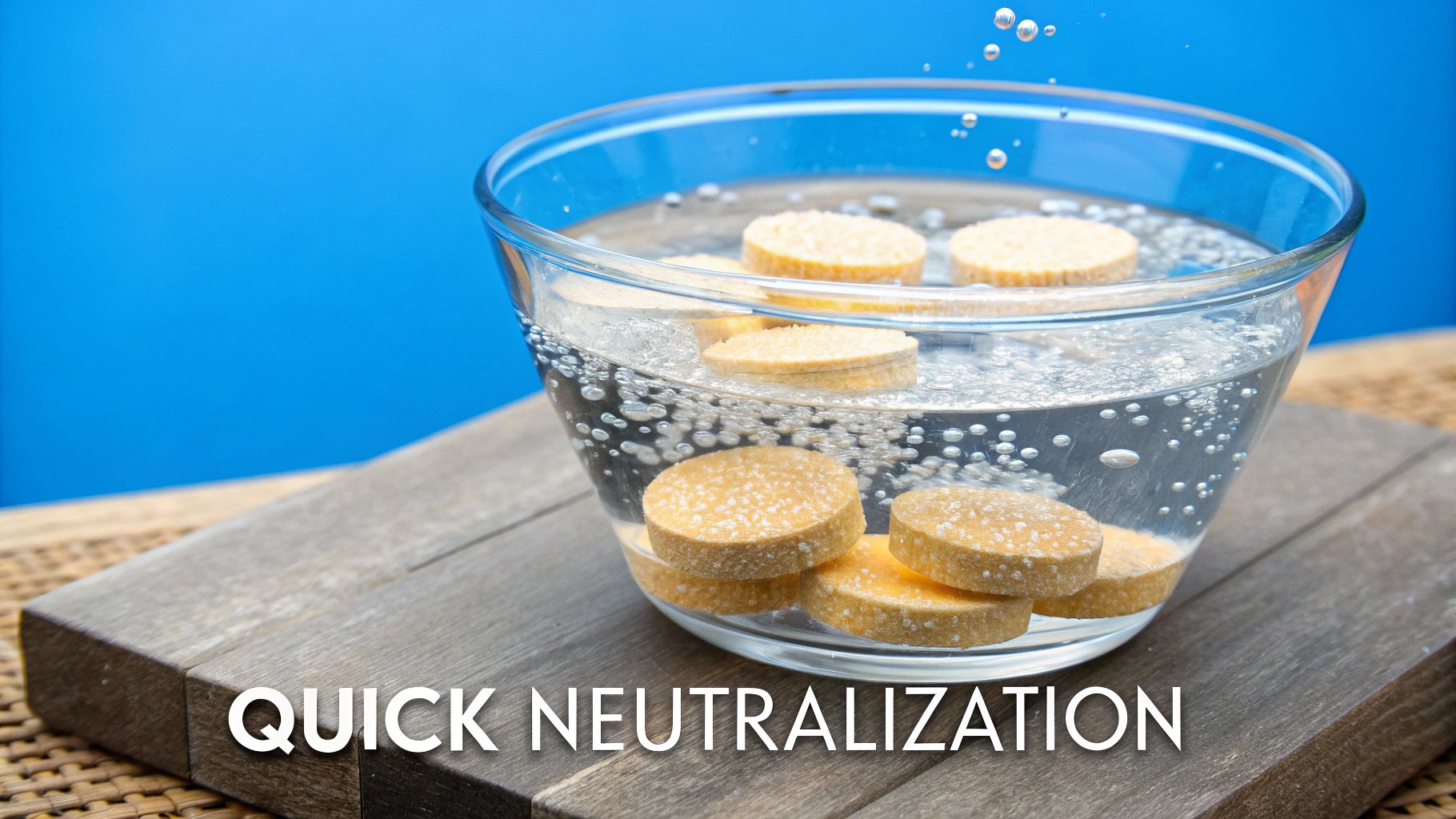
Vitamin C: The Everyday Chloramine Buster
One of the simplest and safest ways to knock out chloramine is with Vitamin C, specifically ascorbic acid. It's shockingly effective. A tiny pinch of pure ascorbic acid powder can neutralize all the chloramine in a gallon of water in just seconds.
This method has become incredibly popular for a few key reasons:
- It's Safe: You’re literally just adding a vitamin to your water. It’s completely non-toxic for people, pets, and plants.
- It's Fast: The reaction is almost instantaneous. No waiting around.
- It's Accessible: You can find ascorbic acid powder easily online or at most health food stores.
A perfect example is prepping bathwater. If you have sensitive skin, soaking in chloraminated water can leave you feeling dry and itchy. By adding about 1,000 mg (roughly a quarter teaspoon) of ascorbic acid powder to your bath as it fills, you can neutralize those harsh chemicals and enjoy a much gentler soak.
Campden Tablets for Hobbyists
For homebrewers and aquarists, Campden tablets are the gold standard. These small tablets contain potassium metabisulfite or sodium metabisulfite, potent compounds that obliterate both chlorine and chloramine on contact.
Why are they so beloved by hobbyists? Because precision is everything. When you’re brewing beer, even a trace of chloramine can react with yeast and create a medicinal, plastic-like off-flavor called chlorophenol. One crushed Campden tablet is typically enough to treat up to 20 gallons of brewing water, keeping your batch clean.
It’s a similar story for fish owners. Chloramine is lethal to fish—it damages their gills and can quickly lead to death. Treating tap water with a Campden tablet before adding it to a tank is a non-negotiable step for a safe aquatic environment. Just be sure to follow the dosage instructions carefully, as a little goes a very long way.
Important Takeaway: Chemical neutralization is a fantastic tool for specific, small-scale tasks. Whether you're filling a fish tank, watering delicate orchids, or drawing a bath, these methods offer an instant solution without the cost of a full filtration system.
Understanding the Chemistry
The science behind this is pretty straightforward. Compounds like ascorbic acid and sulfites are known as "reducing agents." They essentially donate electrons to the chloramine molecule, which forces its chemical bonds to break apart, rendering it harmless.
This chemical stability is exactly why standard treatments like UV light just bounce off chloramine. You need something that can chemically dismantle it. While catalytic carbon is the most robust filtration method, removing up to 90-95% of chloramines, chemical reduction with ascorbic acid or sulfites gives you an immediate alternative for specific uses. To dive deeper into these different treatment methods, check out the official guidance on chloramine from Health Canada.
When to Choose Neutralization Over Filtration
So, how do you decide when to use a pinch of Vitamin C versus relying on your filter? It all comes down to the scope of the job.
- Use Neutralization For:
- Fish Tanks: A perfect use case for preparing new water for an aquarium.
- Houseplants: Sensitive plants like orchids can suffer from chloramine. Treating their watering can is a smart move.
- Homebrewing: Protecting your beer or wine from nasty off-flavors is critical.
- Soothing Baths: An easy way to protect your skin during a long soak.
- Fermenting Foods: Making sourdough or kimchi? Neutralize your water to protect those beneficial microbes.
These methods are ideal when you need a few gallons of chloramine-free water, right now. They are not, however, a substitute for a whole-house system. Constantly treating every glass of water you drink or all the water for your shower this way would be impractical. For everyday, whole-home protection, filtration is still king.
How to Choose the Right Filtration System
Feeling swamped by all the options for getting chloramine out of your water? Let's cut through the noise. Choosing the right filtration system isn’t about finding the single “best” one—it’s about finding the best one for you. It really comes down to a balance of your budget, your daily routine, and your home’s specific water situation.
The secret is to ask the right questions before you start shopping. Think of it like buying a car. You wouldn't get a two-seater sports car for a family of five, and you wouldn't try to parallel park a giant SUV on a tiny city street. Water filters are no different; the perfect fit is all about your circumstances.
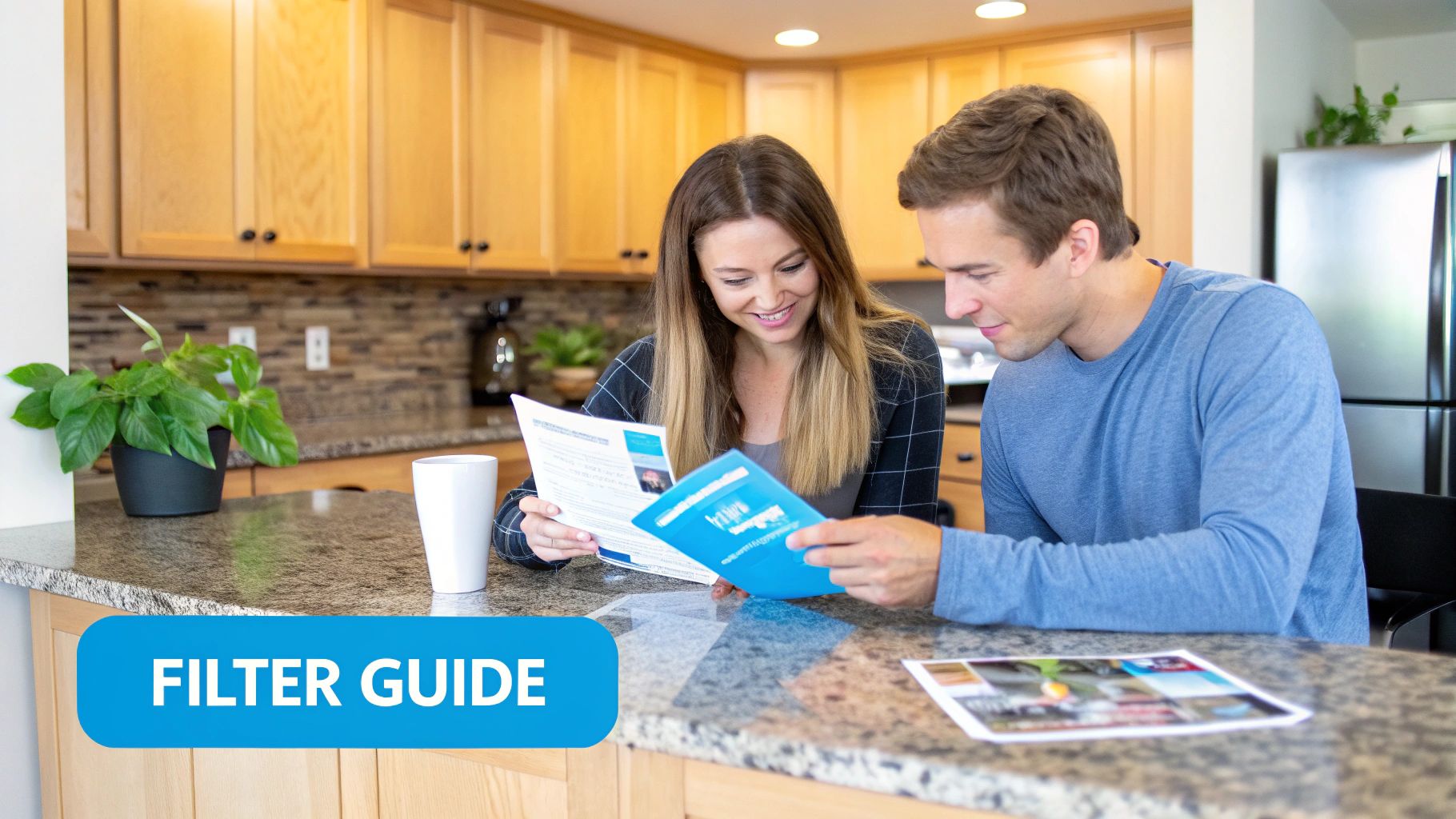
Assessing Your Home's Needs
First things first, let’s get a handle on the scale of your chloramine issue and what your daily water demands look like. A couple living in a small condo has completely different needs than a family of five in a sprawling house.
Start with your household size and how much water you use each day. A bigger family doesn't just drink more water—they also do more laundry, take more showers, and use more water for cooking. All that high demand puts a real strain on a filter, meaning a small under-sink unit might not be able to keep up.
This is where you need to be honest with yourself. Are you mostly worried about the chemical taste in your drinking water? Or are you also trying to stop chloramine from drying out your skin in the shower? Your answer will point you toward either a targeted point-of-use (POU) system or a comprehensive point-of-entry (POE) whole-house solution.
Whole-House vs. Under-Sink: A Practical Comparison
Let's look at a couple of real-world scenarios to make this choice clearer.
Scenario 1: The Family of Five
Meet the Millers. They've got three active kids, a dog, and a big house. They’ve noticed a chemical taste in the tap water, and their youngest's eczema seems to flare up after bath time. For them, a whole-house (POE) system with catalytic carbon is the clear winner. It’ll deliver chloramine-free water to every single faucet, protecting their child’s sensitive skin, making their drinking water taste better, and even helping their dishwasher and washing machine last longer.
Scenario 2: The Condo Couple
Now, picture Sarah and Tom in their two-bedroom condo. Their main goal is simple: get rid of the chemical smell in their drinking water and coffee. They don’t own the place, so a major plumbing overhaul for a whole-house system is a non-starter. A high-quality under-sink (POU) catalytic carbon filter is their perfect match. It's a more affordable, less invasive solution that fixes their main problem without treating water they aren’t even drinking.
If you happen to be building a new home, you have a unique opportunity. It's much easier to start thinking about integrating water quality solutions into your new home design from the very beginning.
Your choice isn't just about technology; it's about lifestyle. The best system is the one that seamlessly integrates into your daily life, solving your specific problems without creating new ones.
Your Essential Buyer's Checklist
Once you've decided between a whole-house and a point-of-use system, it's time to dig into the specific models. Don't just get fixated on the price tag. The true cost of a system includes its performance, how long it lasts, and the maintenance it'll need down the road.
Here’s a quick checklist to keep in your back pocket:
- Flow Rate (GPM): Measured in Gallons Per Minute (GPM), this is absolutely critical for whole-house systems. A low flow rate means a frustrating drop in water pressure when the shower and the dishwasher are running at the same time. Find a system that can handle your peak usage.
- Filter Lifespan & Capacity: How many gallons can the filter handle before it needs replacing? For under-sink systems, this might be every six months. For big whole-house systems, the catalytic carbon media can last for 5-10 years. A longer lifespan means less hassle and a lower long-term cost.
- Certifications: Always look for certifications from trusted third parties like the NSF (National Sanitation Foundation). Specifically, NSF/ANSI Standard 42 covers the reduction of things like chlorine and chloramine. This is your proof that the filter actually does what the company claims.
- Maintenance: What will it take to keep this thing running? Is it a simple cartridge swap you can do yourself in a few minutes, or will you need to call in a pro? Be realistic about how much time and effort you're willing to commit.
Navigating these choices can be tough, but expert resources can really help. You can get more practical guidance and in-depth reviews by checking out the expert advice on water filters, which is great for comparing specific models.
By thinking through these key factors—your household needs, the right scale for the solution, and these performance metrics—you can go from feeling overwhelmed to feeling confident. You’ll be ready to pick a chloramine removal system that fits your home, your budget, and your life perfectly.
Keeping Your System Running Flawlessly
So, your new filtration system is in, and the water tastes fantastic. Job done, right? Well, not quite.
Getting the system installed is the big first step, but the real secret to enjoying chloramine-free water for years is consistent maintenance. Think of it like your car—you wouldn't just drive it forever without an oil change and expect it to run perfectly.
A little upkeep protects your investment and, more importantly, prevents that chemical taste from creeping back into your life. When you skip maintenance, you’re not just letting chloramine through; you could also be setting yourself up for lower water pressure or even damage to the system.
Spotting The Signs Of A Tired Filter
Your filter will start dropping hints when it needs some attention. The trick is to know what you're looking for before it becomes a major issue. Most of the time, the red flags are subtle at first, but they clearly signal that your catalytic carbon media is getting worn out.
Keep an eye (and nose) out for these tell-tale signs:
- The Return of "That Smell": This is the most obvious one. If you start noticing that distinct chemical or "pool water" odor again, it means the carbon media is saturated and can't break down chloramine anymore.
- A Drop in Water Pressure: Shower not feeling as powerful as it used to? Faucets seem a little sluggish? A clogged filter is the usual suspect. Over time, as it traps sediment, it can start to restrict water flow.
- A Change in Taste: You got used to pure, clean water pretty fast. If it starts to taste "off" or metallic again, your filter is probably exhausted.
Your own senses are your best maintenance tool. The second you notice a change in your water's taste, smell, or flow, that's your filter telling you it needs help. Ignoring it just means you're no longer getting the clean water you paid for.
Creating A Simple Maintenance Routine
Staying on top of filter changes doesn't have to be a drag. The best way to handle it is to be proactive, not reactive. Set a schedule and stick to it, and your system will always be working at its best.
Here are a few tips to make it painless:
- Mark Your Calendar: The day you install a new filter, check the manufacturer's recommended replacement schedule. Go ahead and set a reminder on your phone or calendar for a week before it's due.
- Order Spares in Advance: Don't wait until the last minute to buy a replacement. Having a new filter on hand means you can swap it out right away with zero downtime.
- Keep a Log: For those big whole-house systems with media that lasts for years, it’s super easy to forget when it was last serviced. Just keep a simple log in your utility room with the installation date and the next service date.
While this guide is all about your chloramine system, good homeownership involves keeping everything in order. For a bigger picture, you might find a comprehensive monthly home maintenance list helpful for keeping your whole property in great shape.
Ultimately, a little planning makes all the difference. Regular maintenance is the only way to guarantee your system keeps delivering the pure, chloramine-free water your family deserves. It’s a small bit of effort that pays off with every glass you drink.
Common Questions About Chloramine Removal
When you start digging into how to get chloramine out of your water, you’ll run into a ton of questions. It's easy to get lost in a sea of myths and half-truths, so let's cut through the noise and get you some clear, straightforward answers.
Will a Standard Water Pitcher Filter Work?
This is probably the most common question, and the answer is a hard no. Those basic water filter pitchers you grab off the shelf at Target or Walmart? They almost all use standard activated carbon. That stuff is great for chlorine, bad tastes, and weird smells, but it's completely outmatched by the much tougher chloramine molecule.
Chloramine is chemically way more stable and just doesn't break down easily. To actually get rid of it, you need a filter specifically built for the task, which almost always means it uses catalytic carbon. Without that special media, your pitcher is just letting chloramine flow right on through to your glass.
Can I Just Boil the Water?
Boiling is another old wives' tale that just doesn't hold up for chloramine. It works for free chlorine, which will gas off pretty quickly when you heat water, but chloramine is incredibly stubborn.
You’d have to keep a pot of water at a rolling boil for a ridiculously long time to even make a dent in the chloramine levels. Honestly, it's not a practical or reliable way to treat your water at all. You're much better off sticking with proven methods like proper filtration or chemical neutralization if you want real results.
Don't waste your time or energy trying to boil chloramine away. The chemical bond is simply too strong, making filtration with the right media the only truly effective household solution.
What About Reverse Osmosis Systems?
Now this one is a bit more complicated. A reverse osmosis (RO) system can be fantastic for chloramine removal, but there’s a catch: its success is 100% dependent on its pre-filters. The RO membrane itself, which is the real workhorse of the system, can't remove chloramine.
Good news is, any quality RO system is designed with this in mind. They come equipped with one or more pre-filter cartridges loaded with catalytic carbon blocks. These pre-filters are there specifically to tackle chloramine before the water gets to the sensitive RO membrane. This not only purifies the water but also protects the membrane from damage. If you're looking at an RO system, just make sure you see it's officially rated for chloramine reduction.
How Do I Know if My City Uses Chloramine?
Finding out what’s in your tap water is actually simpler than you’d think. Your local water utility is required by law to publish an annual water quality report, which you might see called a Consumer Confidence Report (CCR).
This report is a complete breakdown of your water source, treatment methods, and what’s in it, including the specific disinfectant used. You can almost always find it on your utility's website, or just give them a call and ask for a copy. It will tell you in black and white whether you’re dealing with chlorine, chloramine, or a combination of both. No more guesswork.
Ready to stop guessing and start enjoying pure, chloramine-free water? The experts at Water Filter Advisor provide in-depth guides and unbiased reviews to help you find the perfect filtration system for your home. Explore your options and make a confident choice today at https://www.waterfilteradvisor.com.
- October 12, 2025
- 0
- Uncategorized
